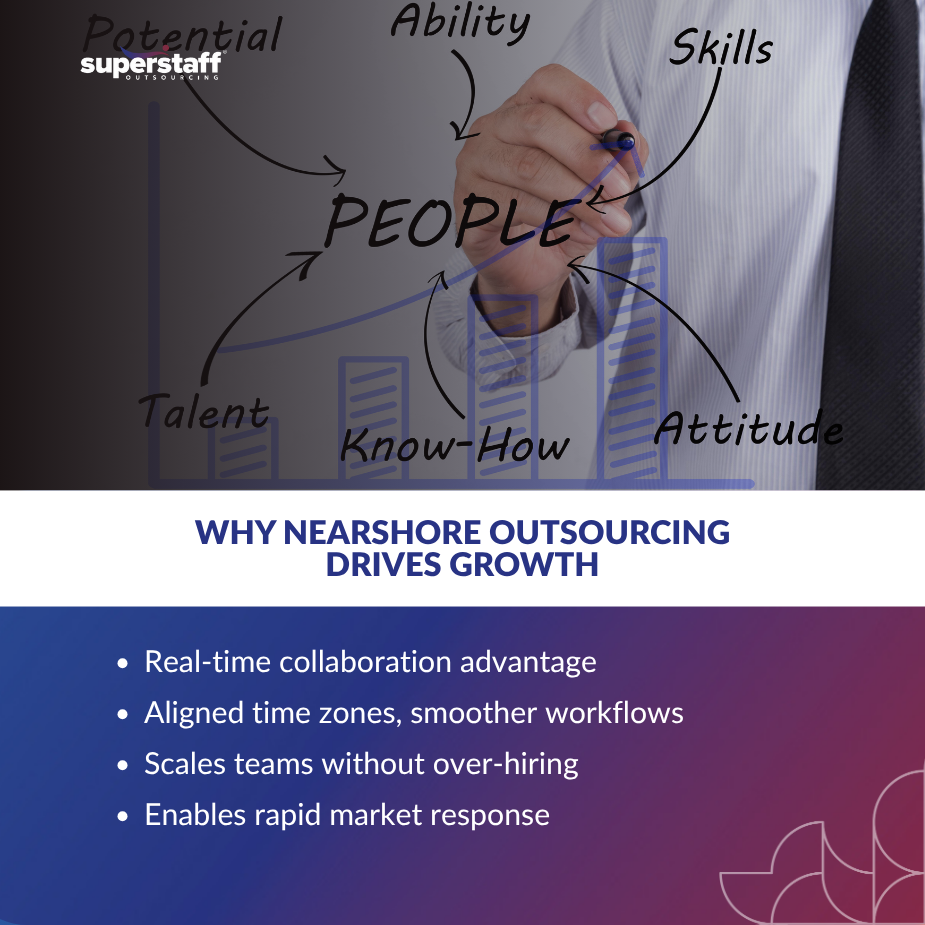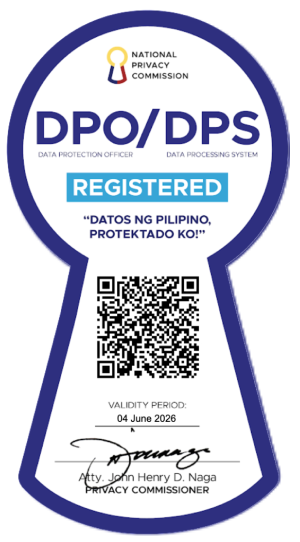
In today’s fast-paced market, where you hire is just as important as who you hire. Business leaders are realizing that location strategy is no longer just about cutting costs—it’s about gaining a competitive edge. Nearshore and offshore outsourcing are no longer back-office solutions. They’ve become front-line tools for expansion, agility, and innovation.
With the right global talent strategy, companies can scale faster, work smarter, and compete globally. This blog explores how businesses use nearshore and offshore teams to stay ahead—and how to do it right.

Nearshoring Offers Speed, Synchronicity, and Cultural Alignment
Nearshore outsourcing is redefining how modern businesses operate. For U.S.-based companies, building teams in regions like Latin America unlocks a powerful advantage: working in the same time zone. This isn’t a small detail—it changes the entire rhythm of collaboration.
When your nearshore outsourcing team starts their day at the same time as your in-house staff, you remove the lag. You no longer have to wait a day to get an update, review a document, or align on next steps. That synchronicity means faster execution and better problem-solving.
There’s also the benefit of cultural proximity. Teams in Colombia, for instance, are well-versed in American communication styles, workplace expectations, and consumer behaviors. That makes nearshore outsourcing particularly effective in customer-facing roles, content creation, sales development, and other areas where cultural nuance matters.
Managers appreciate how easy it is to lead nearshore outsourcing teams. From easier scheduling to smoother onboarding, the experience feels more integrated and familiar. For fast-growing companies, this leads to less friction and quicker results.
But when it comes to scaling volume-heavy functions—especially those with a high demand for skilled, affordable labor—offshoring remains a strategic powerhouse.
Offshoring Remains a Top Strategy for Scaling With Quality at Lower Costs
Offshoring isn’t just about saving money. It’s about unlocking world-class talent in some of the most mature outsourcing markets. The Philippines continues to lead the way, especially in customer experience, IT support, finance, and healthcare services.
With strong English proficiency, a deeply ingrained service culture, and a history of serving U.S. clients, the Philippines offers a level of professionalism that companies can trust. That’s why businesses large and small continue to turn to offshore partners to build their core operations from the ground up.
While nearshore outsourcing enhances responsiveness, offshoring gives businesses a cost-effective way to handle complex, labor-intensive functions at scale. Together, they enable end-to-end support across time zones and functions.
What makes offshoring especially compelling is the ability to scale quickly—without the overhead of hiring and maintaining large domestic teams. While cost savings remain a strong factor, the real draw is quality at scale. Teams are trained, experienced, and ready to handle complex tasks with precision.
This is where nearshore outsourcing complements offshoring so well. Together, they form a flexible, scalable global workforce strategy that serves every part of the business.
A Blended Nearshore-Offshore Approach Maximizes Reach, Resilience, and Results
Companies that rely solely on one outsourcing model may find themselves limited. A nearshore-only model can be fast but costly. An offshore-only approach may offer savings but lack instant collaboration. The smartest companies blend both.
A hybrid nearshore outsourcing and offshore structure lets businesses balance real-time collaboration with high-volume capability. For example, a company might manage client-facing work through a nearshore team in Colombia while delegating back-office functions to an offshore team in the Philippines. This structure creates a seamless workflow across different time zones while maximizing ROI.
Another advantage of hybrid outsourcing is business continuity. When challenges arise—whether technical, geopolitical, or operational—companies with distributed teams are less vulnerable. Redundancy across regions ensures that operations don’t come to a halt.
Most importantly, nearshore outsourcing offers the control and speed needed to handle client interactions and real-time feedback, while offshore operations handle round-the-clock execution. Together, this dual-model outsourcing strengthens every part of the customer journey.
That adaptability drives more than efficiency. It fuels top-line growth.
Global Talent Strategies Directly Fuel Business Expansion and Innovation
Outsourcing isn’t just about trimming costs anymore. Today’s most successful companies use global talent strategies to push forward into new markets, launch new products, and deliver better experiences to their customers.
Nearshore outsourcing has made it easier for U.S. companies to manage operations during regular business hours while keeping close communication with their teams abroad. This proximity enables real-time brainstorming, immediate feedback loops, and smoother alignment on projects.
When your in-house teams are no longer bogged down by repetitive tasks, they can focus on what matters most—strategy, growth, and innovation. Meanwhile, nearshore outsourcing keeps your operations moving in real time, while offshore teams work around the clock to support fulfillment, tech, or customer support.
This kind of 24/7 operation doesn’t just reduce downtime. It turns time into a competitive asset. Your customers can be supported at any hour. Your IT systems can be maintained during U.S. off-hours. Your sales team can hand off tasks and wake up to completed work.
It also allows companies to test, iterate, and launch faster than ever. When market opportunities arise, global teams let you move fast without overextending internal bandwidth. Every function, from data processing to lead generation, can scale on demand.
That kind of strategic freedom is why more businesses are investing in nearshore outsourcing—and building broader global team strategies.
Successful Global Teams Require Thoughtful Planning and the Right Partners
Of course, none of this happens by accident. Building a successful global team means aligning your outsourcing model with your business needs—and knowing how to integrate a remote team into your organization without disruption.
It starts with clarity. What are you trying to achieve? Do you need around-the-clock customer support? Are you scaling a product team? Expanding into a Spanish-speaking market? Your goals will determine whether nearshore, offshore, or hybrid makes the most sense.
Companies adopting nearshore outsourcing should also assess cultural compatibility, industry-specific expertise, and operational agility. These factors directly influence how quickly a team integrates and performs.
Other important considerations include time zone alignment, communication preferences, industry expertise, data security needs, and growth projections. Choosing the right regions—and the right outsourcing partner—can make or break your success.
That’s why many companies look to strategic partners to help with setup, onboarding, and compliance. You don’t just need people; you need systems, training programs, quality control processes, and real-time reporting. These are the foundations of successful remote teams.
Knowing how to integrate a remote team without adding complexity to your existing operations is a skill—and it’s one that the right partner can deliver.
SuperStaff Helps You Build High-Performing Global Teams That Align With Your Goals
At SuperStaff, we understand that every business is different. That’s why we don’t offer one-size-fits-all solutions. Instead, we work closely with clients to build remote teams that reflect their goals, industry standards, and operational rhythms.
Our nearshore outsourcing services in Colombia bring time zone compatibility, bilingual talent, and cultural alignment to U.S. clients. Whether you need customer support, digital content teams, or sales development representatives, we can source and manage high-quality teams that work when you do.
Our offshore outsourcing operations in the Philippines deliver high-volume capability and cost-effective talent across CX, healthcare, finance, and IT support. With deep experience and world-class training programs, our Philippine teams are ready to scale alongside you.
We don’t stop at recruitment. We offer end-to-end solutions—from onboarding and performance management to KPI tracking and reporting. Our clients trust us to act as true extensions of their team, not just vendors.
That’s what makes our hybrid support model so powerful. We combine nearshore outsourcing speed with offshore scale—giving our clients both flexibility and consistency, wherever growth takes them.
Whether you’re exploring nearshore outsourcing, offshore expansion, or a mix of both, SuperStaff can help you get it right from the start.
Nearshore Outsourcing Is the Strategy That Moves Growth Forward
Nearshore and offshore strategies aren’t just trends—they’re growth accelerators. When businesses tap into the right talent in the right locations, they unlock more than efficiency. They gain flexibility, resilience, and the ability to scale in sync with demand.
From cost savings to cultural alignment, 24/7 responsiveness to market expansion, a well-structured global workforce can transform the way companies operate. Nearshore outsourcing gives you real-time collaboration. Offshore outsourcing delivers scalable quality. And when combined thoughtfully, they create a global advantage that’s hard to beat.
Looking to expand with nearshore or offshore talent? SuperStaff is here to help. Our global talent solutions are designed to help you scale smart, stay agile, and reach new heights. Let’s build a team that drives your next stage of growth—on point and on time.






